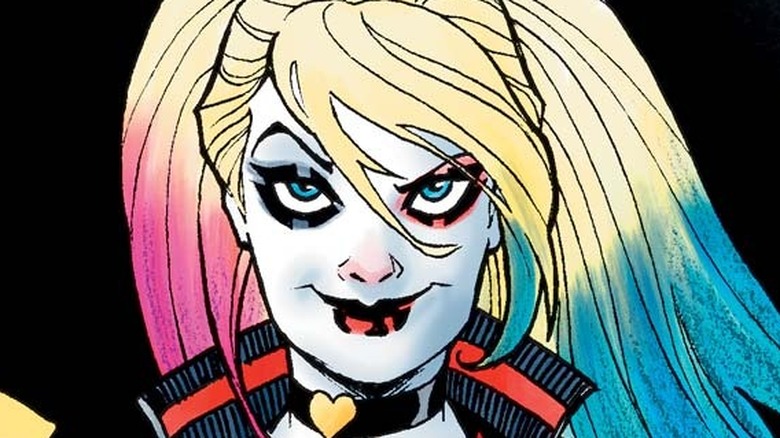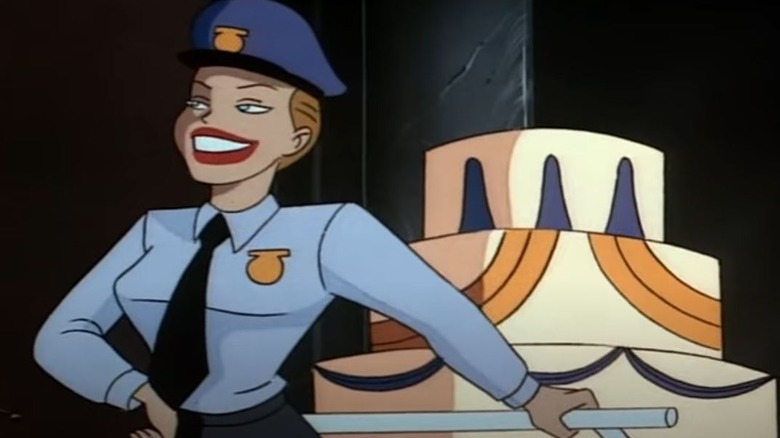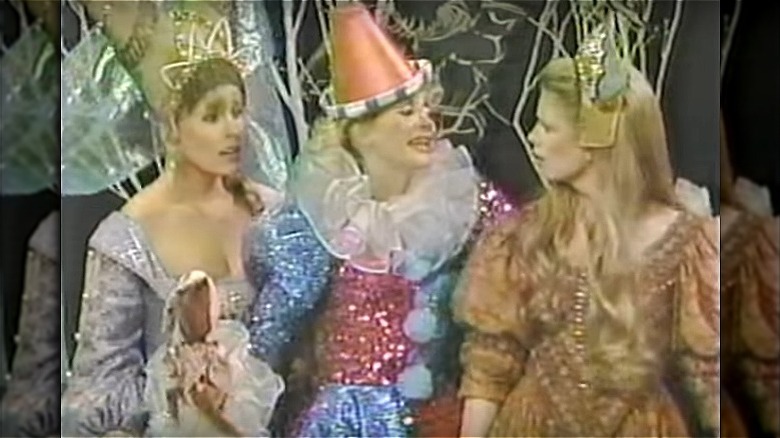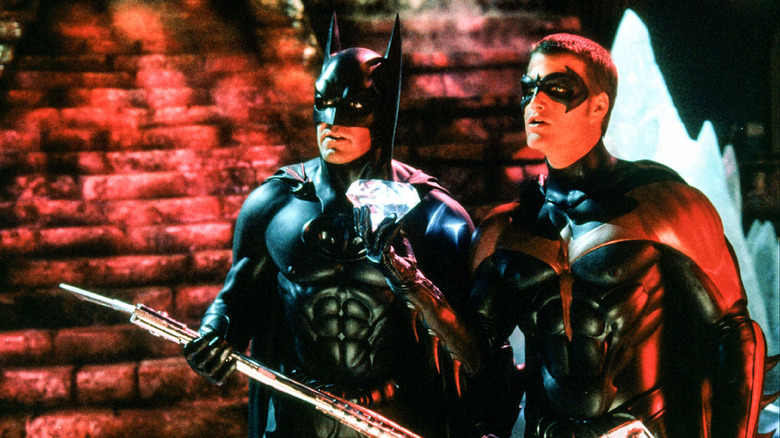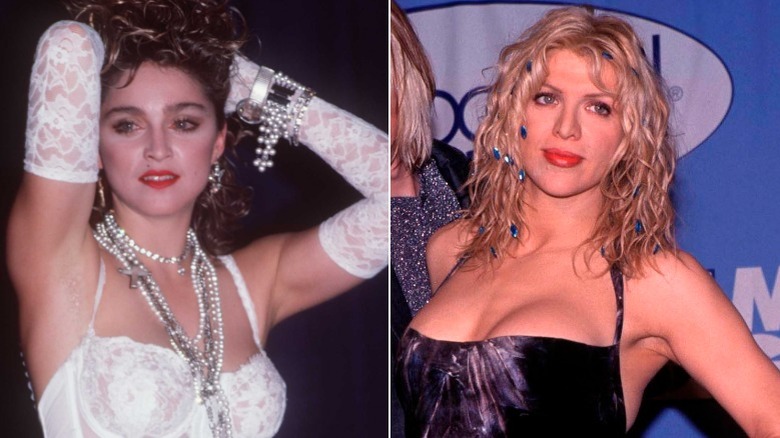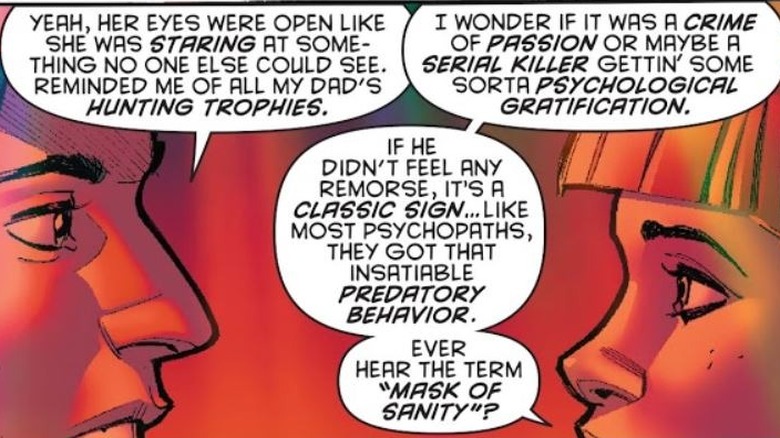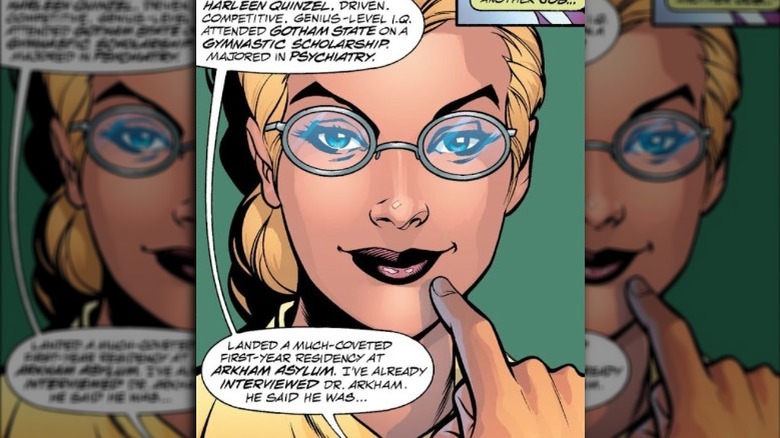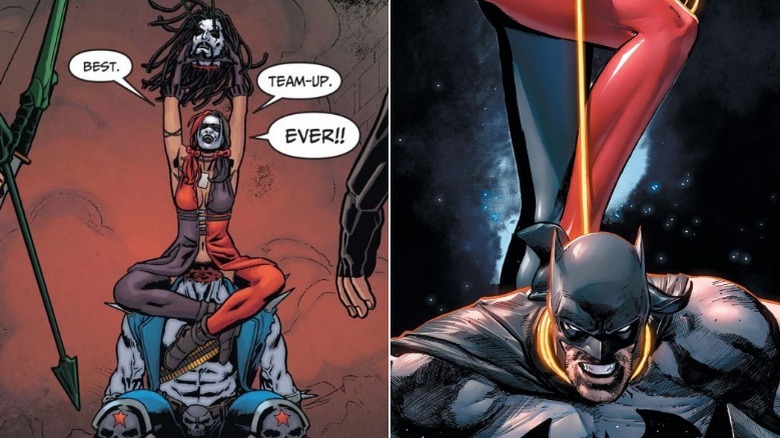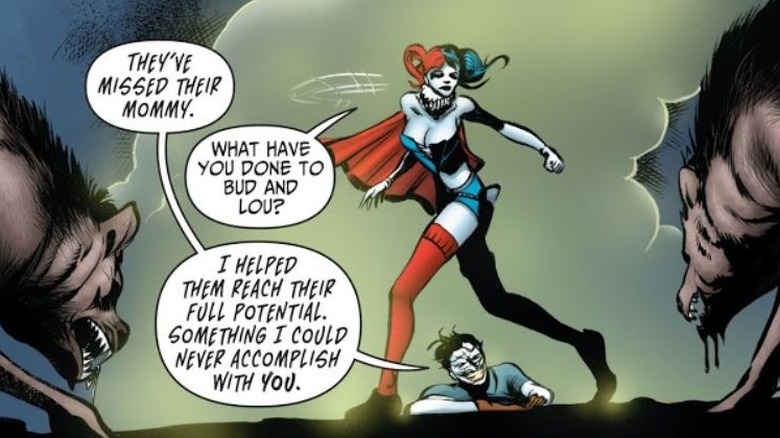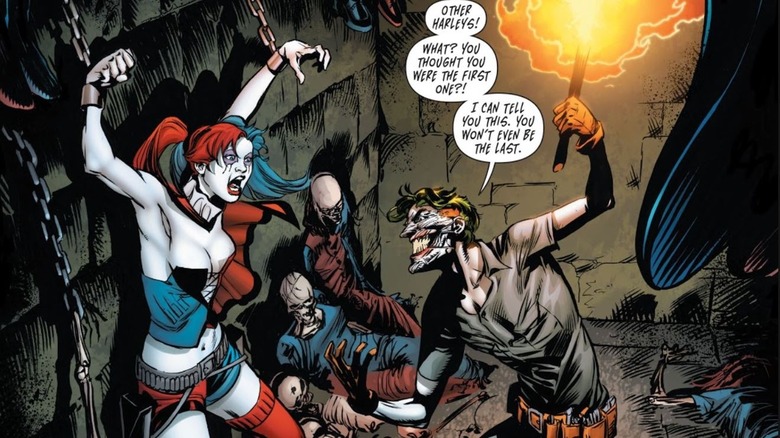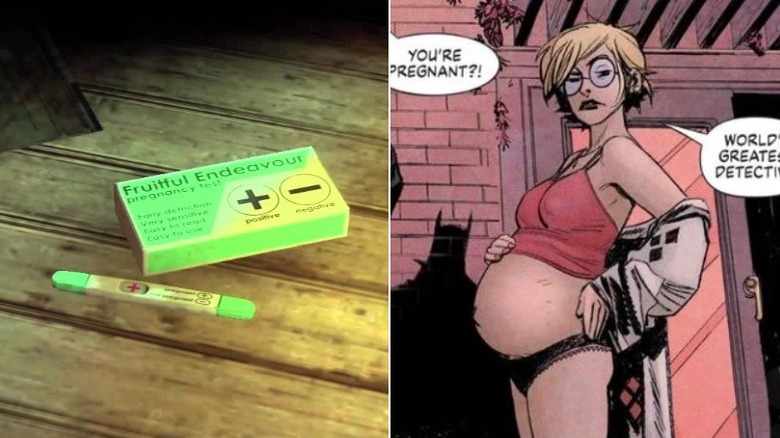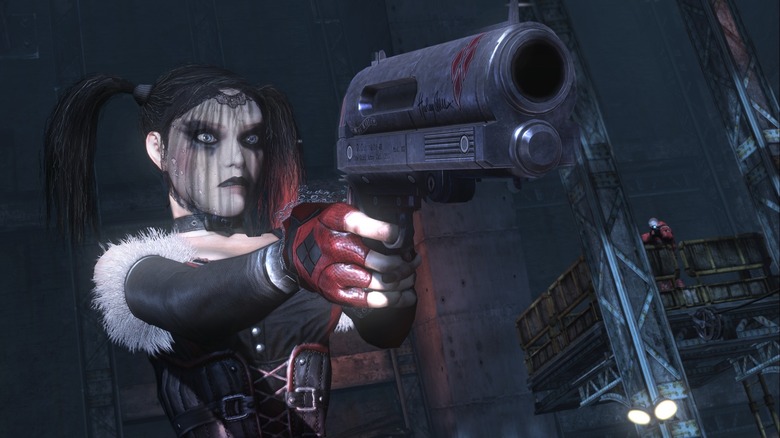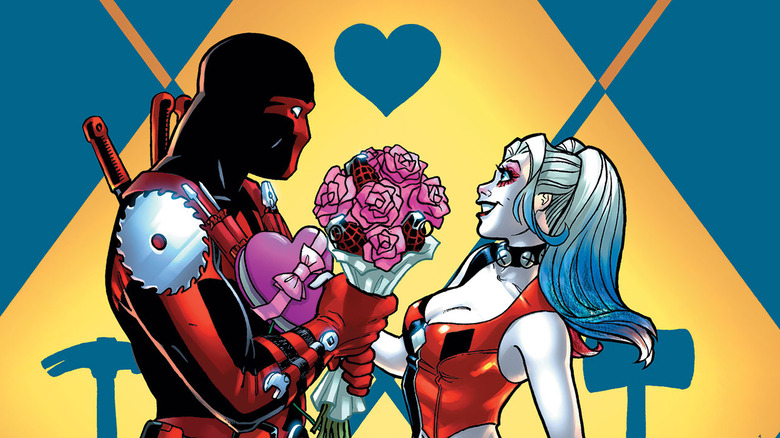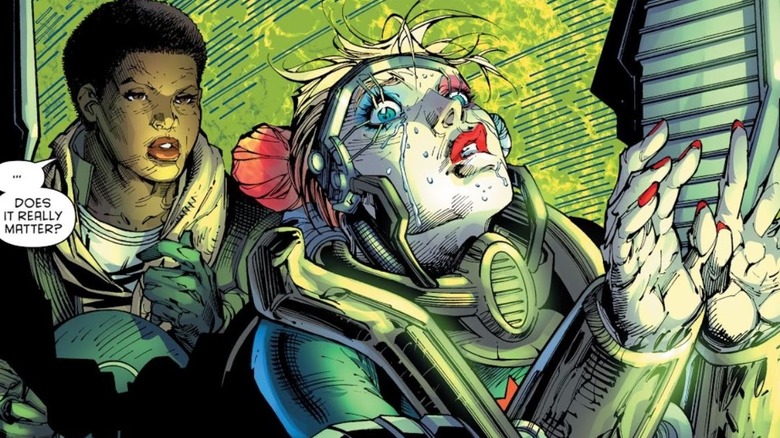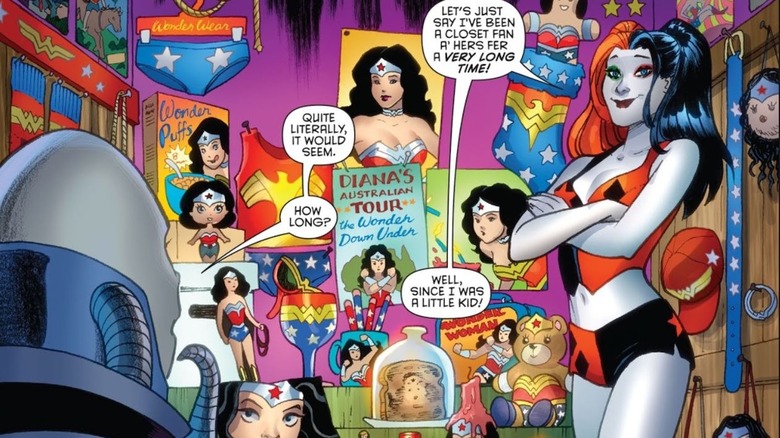The Untold Truth Of Harley Quinn
Ever since her 1992 debut in "Batman: The Animated Series," Harley Quinn has captivated audiences with her goofy charm and relentless optimism. Those endearing qualities helped expand her existence onto the pages of comic books, a feat few other DC characters can claim. Over time, the Clown Princess of Crime grew beyond her simple role as Joker's side-piece into a multi-dimensional, complex, and fully independent character — one who has arguably some of the most enjoyable rides modern comic books have to offer.
It's hard to imagine DC without its beloved harlequin capering through their graphic novels, video games, cartoons, and films. But somewhere in the multiverse, there is a world without Harley Quinn, because she wouldn't have existed without a series of fortuitous, unlikely, and disparate events. Many people know that Harley partially owes her existence to actress Arleen Sorkin, but fewer are aware that "The Princess Bride" and sick days also played prominent roles in her creation. Indeed, there are tons of fascinating facts about Harley even die-hard fans may not know, many of which pack a wallop as big as her mallet. This is the untold truth of Harley Quinn, from the whimsical to the macabre.
One-hit wonder
It's funny how many minor characters wind up becoming regulars the audience can't imagine being without. Superhero fare is no exception, and Harley Quinn is a great example. Harley's first appearance on "Batman: The Animated Series" is indeed a humble one, and almost didn't happen at all.
The year was 1991, and a young Paul Dini was home sick. He was also busy drafting freelance scripts for what would become "Batman: The Animated Series," and trying to conjure ideas for a sidekick to accompany the Joker. "I thought, 'Maybe there should be a girl there,'" he told Vulture. "And I thought, 'Should the girl be like a tough street thug? Or like a hench-person or something?' And then suddenly the idea of someone funny kind of struck me."
There were still many primary elements of the character missing, but this inspiration was key. Talk about humble origins: Harley Quinn was born from a sick day!
The Princess Bride meets Days of our Lives
Back in 1987, Paul Dini's college friend, actress Arleen Sorkin, was busy charming fans as lovable goofball Calliope Jones on "Days of our Lives." According to Vulture, Sorkin suggested to the producers on "Days" that they film a fairy-tale dream sequence after she saw "The Princess Bride" in theaters. The idea was picked up, and Calliope was transformed into a roller-skating harlequin in a sparkly jester costume.
Watching the scene in question, one can clearly see Harley's origins in Sorkin's character-within-a-character. Calliope the jester is very goofy, not afraid of a good scrap with the guys, prone to breaking the fourth wall, and ready with a ribald joke. This clip was on a VHS featuring Sorkin's favorite moments from the show, which she gave to Dini. Dini popped it in while working from home on his fateful 1991 sick day. Sorkin's zany performance ignited a spark, and Harley Quinn was born.
Sorkin was later cast as Harley Quinn in "Batman: The Animated Series." As Harley, she set the standard for the character's nasally, Brooklyn-accented voice.
Harley unchained
Although the character was introduced in 1992, Harley Quinn didn't get an official live-action debut until Margot Robbie's bombshell performance in 2016's "Suicide Squad." It's hard to imagine anyone else being cast as the character now, but had things gone differently, audiences may have been introduced to a live-action Harley over a decade earlier.
Back in the late '90s, a fifth installment was planned for the original "Batman" film franchise. According to The Hollywood Reporter, the movie would have hit theaters in 1999, but was canceled after the dismal failure of "Batman & Robin." Had that movie been a success, the fifth "Batman" film would have been directed by Joel Schumacher, with Mark Protosevich being brought in for the screenplay.
As it turns out, the two met after wrapping up production on "Batman & Robin." Schumacher proposed they take the franchise in a more serious direction –a direction, it turns out, that would have included Harley Quinn. This movie would have been called "Batman Unchained," and was set to feature the Scarecrow and the Joker alongside Quinn as the film's big baddies. That's right: The world missed out on a late '90s Schumacher-helmed Batman fever dream featuring what would have been the first live-action Harley Quinn acting alongside Nic Cage (if Schumacher had gotten his way) and Jack Nicholson. Whether that's a blessing or a curse is up to you.
A harlequin by any other actress
Mark Protosevich's script for "Batman Unchained" reimagines Harley Quinn as a toymaker who learns she's the Joker's daughter. This sets her on a path of vengeance against Batman. This Harley would have been, according to Protosevich, "sadistic in a mischievous, fun sense." She was also set to be a major part of the movie, ultimately enjoying a redemptive arc that would reaffirm her status as good person, despite everything.
Honestly, it sounds like Protosevich nailed the base personality of the character in his script, outside the major and obvious change of Harley being the Joker's daughter, instead of his lover. But who would have played the iconic harlequin? Well, Protosevich's agents at CAA set him up for lunch with Courtney Love, who was also represented by that agency. It wasn't exactly a formal audition, but it was a start. Rumors have also swirled for years that pop icon Madonna was considered for the role, but evidence is thin on the ground.
For better or for worse, Protosevich's first draft was completed right as "Batman & Robin" hit theaters in June 1997. The moviegoing public's immediate derision doomed "Batman Unchained" to the dustbin of cinematic history.
Not that innocent
When Dr. Harleen Quinzel first transforms into her villainous alter ego, Harley Quinn, it seems a little out of the blue. Since her 1992 introduction, however, additional material has expanded upon Harley's origins, which reveal more nuanced and macabre aspects of her innate personality.
This is clearly seen in 2014's "Secret Origins" #4, which tells the story of Harley's high school crush on her classmate, Bernie Bash. After disclosing that she's being bullied, Bash murders the offender by throwing her into oncoming traffic. He goes to juvenile detention "'fer, like, ever," and Harley experiences her first heartbreak, instead of remorse.
She then does what any normal kid would do, and secretly breaks into Bash's house in search of a personal belonging to keep as a memento. Inside, young Harley finds a room full of taxidermized animals, which "explains a few things," and goes to show how drawn she is to those with twisted inclinations. Young Harley takes a stuffed beaver with her, who she names Bernie.
One smart cookie
Early origin stories like 1993's "Mad Love" imply Harley was a mediocre student who slept with her teachers to get good grades. Later, when she becomes Harley Quinn, she's portrayed as a ditz who is clueless half the time as to what's going on around her. However, Harley has grown into a more complex character over the years who is booksmart and surprisingly adept at manipulating others.
It's been revealed in some stories, like "Secret Origins" #4, that Harley plays the role of the bimbo because that's the role Joker prefers of his harlequin. Also, pretending she's less intelligent than she truly is adds to her ability to manipulate others.
Harley is described as a bonafide genius by an ex-FBI profiler in the pages of the "Larger Than Life" storyline in 2000's "Harley Quinn" #5. Moreover, in the 2014 animated film "Assault on Arkham," Amanda Waller shares that Harley has "an encyclopedic memory of Arkham's layout and logistics." Harley even passes Batman's lie detector test while being deceitful.
A force to be reckoned with
Time and again, Harley Quinn has used her cunning, intelligence, and unpredictability to take down impressive opponents. Even as early as "Mad Love," she is able to single-handedly take down Batman — only the Dark Knight's own quick thinking and the Joker's jealousy save him that time. Harley has also survived bloody beat-downs with the Joker and come out on top multiple times, most memorably during an epic break-up in 2014's "Harley Quinn" #25.
What are Harley's other martial successes? Well, she takes over Belle Reve and surprises the Unknown Soldier with a knife in 2011's "Suicide Squad" #21. Harley even acquires superpowers in 2016's "Harley's Little Black Book" #2, when she battles Hal Jordan after acquiring a merged Red and Black Lantern Power ring second-hand from a site called "Webay." One of the more extreme examples of Harley vanquishing another is when she faces off against Lobo in 2013's "Injustice: Gods Among Us Annual" #1: She manages to distract him and steal a superhuman pill he reveals he's been taking, resulting in Harley decapitating the evil alien with her bare hands.
Harley has even stood against multiple superheroes at once, like when she faces off against Batman, Wonder Woman, and Superman simultaneously in 2018's "Heroes in Crisis" #2. The tricky clown escapes by stealing the Lasso of Truth from Wonder Woman and kryptonite from Batman, which he'd blatantly lied to Superman about having earlier. Talk about awkward!
Deaths in the family
Harley Quinn is the proud owner of a pair of hyenas named Bud and Lou in "Batman: The Animated Series." They've been together ever since, frequenting comic books and video games like "Injustice 2." One of the most horrific battles Harley has had to face thus far, in fact, is against Bud and Lou in 2011's "Suicide Squad" #15.
An assumed-dead Joker comes out of hiding to kidnap Harley from Deadshot's funeral in this issue, because he's jealous of Harley's affection for Deadshot and the independent life she's created with the Suicide Squad. Joker can't handle her fixating on anything or anyone but him, and now that she has, she must pay for her perceived wrongdoing. After somehow knocking out the rest of the funeral attendees, the Joker brutally punches Harley in the face, takes her to his lair, and tries to make her cut her face off like he has.
Thankfully, she escapes — only to meet a rabid Bud and Lou, who Joker has unhinged on purpose. As a result, Harley is forced to protect herself from her "babies" in order to survive, breaking their jaws in the process. It's a horrible reminder of how truly awful the Joker is. Go snuggle something cute and fuzzy while you let the knowledge of this one wear off.
A dungeon full of Harleys
After surviving her horrific encounter with Bud and Lou, Harley goes on to face an even darker reality. She continues duking it out with the Joker, who poisons her, then drags her incapacitated form into his dungeon. When she finally regains consciousness, she wakes to a nightmare. She has been chained to the walls by her wrists and left for dead, surrounded by the skeletons of previous Harleys. Apparently, the Joker transformed other women before her, only to become disappointed and eventually discard them like old toys. We all like to think our sense of individuality helps define who we are, including Harley. A shocking event like this throws her very sense of self into question.
Thankfully, Harley keeps it together and is ultimately able to escape ... but only by resorting to means as gruesome as anything she's experienced at the Joker's hands. Horribly, when the Joker finds Harley has the will and fortitude to escape his bonds, he declares she just may be "his" Harley after all.
Baby momma
Despite all the terrible things the Joker has done to Harley, she returns to him again and again. She's even fantasized about having a family with him. Although the Joker and Harley might not seem like ideal parent material, there do exist a few stories in which they produce offspring. In 2017's standalone "Batman: White Knight" series, which examines a world in which the Joker becomes sane, he and Harley are able to have two children, Jackie and Bryce.
Harley also has kids in the "Injustice: Gods Among Us" universe. When she and Black Canary are about to face off in the pages of 2014's "Injustice: Year Two" #7, Canary is overcome from morning sickness and has to stop. Harley immediately sympathizes, because, she reveals, she knows what it's like to be pregnant from having her own daughter, Lucy. She also dreams up the memorable image of Black Canary in the third trimester, still rocking her fishnets — which is "seared" into her brain, and now ours too.
Rocksteady Studios also drops a hint that Harley could be carrying the Joker's child in 2011's "Arkham City," when players find Joker's Steel Mill office. Inside lies a positive pregnancy test, next to a baby crib containing a Scarface puppet repainted to resemble Mr. J himself. Harley's mournful voice can even be heard singing a morbid lullaby during the end credits of the game — the lyrics of which are written on Harley's baseball bat in 2016's "Suicide Squad."
Harley's revenge
After "Arkham City" hinted that Harley might be pregnant, fans were abuzz over the potential implications. Would there be a real baby Joker sleeping in the crib in the next game, in place of the creepy, modified Scarface puppet? This anticipation was blunted in anticlimactic fashion, however, when the "Harley's Revenge" DLC hit shelves in 2012.
In this follow-up, it's heavily implied that the pregnancy test was a false positive: Many negative tests are seen scattered about on the floor in place of the single positive result, next to a label warning false positives may occur. No further explanation is given for the pregnancy storyline.
However, some fans believe that Batman may have caused a miscarriage by throwing Harley around through the player's actions in "Arkham City." This theory adds additional depth to her rage and hatred towards Batman in her extension of the games' storyline — she's suffered the loss of her man and her unborn baby. If true, this would account for some of Batman's most intense collateral damage.
Harley meets Deadpool ... sort of
Consider the zany possibilities of a Deadpool and Harley Quinn crossover. The two would complement each other well, with their penchant for shenanigans, fourth wall breaks, and violence. Although audiences won't get to see a "DeadQuinn" team-up anytime soon, they can get close to the experience by reading the 2014 "Harley Quinn" comic run.
One of the many colorful characters Harley becomes friends with in this series is a smart-mouthed mercenary named Red Tool, who is a silly parody of Deadpool. This is extra-meta, considering Deadpool was originally created as a knock-off of DC's Deathstroke. Red Tool is first introduced in 2014's "Harley Quinn" #3 as an unnamed store clerk who puts his body on the line to save Harley from a love-crazed crowd of zombies.
It turns out the clerk's name is Wayne Wilkins, a play on both "Wade Wilson" and "Slade Wilson." After recovering in the hospital, he returns with a new bionic arm and a tool-obsessed personality. He's also fixated on Harley Quinn, who he believes will follow through on the promise she made to "marry him" in exchange for his self-sacrifice. Harley rejects his interest, but Red Tool does become a part of her eclectic crew, which includes an egg in a robot suit, an elderly cybernetic man who uses a wheelchair, and a half-man-half-goat dude.
Pushed to the brink by Amanda Waller
Amanda Waller has displayed an unparallaled ability to be cold, callous, and calculating. As such, she views those in the Suicide Squad as pawns to be deployed for her purposes. Harley Quinn in particular suffers greatly under Waller's various programs of torture and brainwashing.
These tendencies are implied in movies like "Suicide Squad" and "Assault on Arkham," when audiences catch glimpses of the abuse that takes place under her jurisdiction at sites like Belle Reve. However, the sequences of forced feeding and inhumane conditions seen in those films pale in comparison to the brutal torture seen in the pages of comic books. One of the more savage examples is in 2016's "Harley Quinn & the Suicide Squad April Fool's Special," in which Waller implements extreme measures to prepare Harley for impending battle against superheroes.
Strapped to a chair and unable to blink, Harley is inundated with TV screens pumping anti-superhero propaganda into her frazzled mind. This causes her to hallucinate the entire plot of the book, in which she takes up psychology again to help villains in a practice she calls "Evil Anonymous." Harley and the reader are equally shocked when this "reality" is eventually revealed as fantasy. When Harley asks Waller if any of her hallucinations were true, Waller brutally replies, "Does it matter?" Talk about harsh!
Wonder Woman's secret admirer
For all the adversity she's faced, Harley Quinn retains an inner resilience that surpasses outside forces. This is one of her most endearing traits: No matter how dire the stakes may be, Harley always manages to enjoy the ride on her terms. It seems she got this strength, in part, from an unlikely source for an anti-hero — none other than Diana of Themyscira, a.k.a. Wonder Woman.
As revealed in 2015's "Harley's Little Black Book" #1, Harley has been an avid fan of Wonder Woman ever since she was a little girl, even going so far as to build a shrine in her closet. Harley was first inspired by the superheroine's strength and independence as a child, when she found the courage to stand up to school bullies by dressing like the character. Her planned self-defense goes a little too far, however, and young Harleen winds up taking the beating into vengeance territory. Wonder Woman would probably frown upon this behavior, but it's kind of hard to feel any pity for Harley's bullies.
Wonder Woman and Harley team up later in the issue, after Harley knocks Diana out and has to impersonate the Amazon by donning her outfit and lasso. When Harley returns her costume later, Wonder Woman declares it is "moist" and in need of changing — to which Harley sheepishly replies, "Sorry. I was excited."
